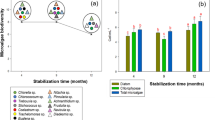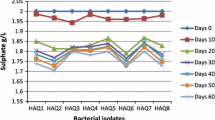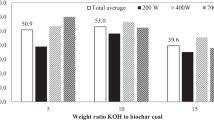Abstract
When wetlands reach maximum treatment capacity to remove heavy metals, removal can still take place through precipitation as sulfide because of the biological reduction of sulfate. To achieve this goal, anaerobic conditions must be attained, a sulfate source must exist, and an adequate substrate for sulfate-reducing bacteria (SRB) is also required. In the present work, two ligneous-cellulosic materials, a brown seaweed and sugarcane bagasse, have been selected as substrates for SRB growth. Experiments were simultaneously conducted in continuous operation in two columns (0.57 L each), one containing the ligneous-cellulosic material plus inoculum and another containing only the ligneous-cellulosic material. In this work, the removal of cadmium and zinc was studied because of their presence in effluents from mining/metallurgy operations. Results obtained indicated that the inoculated reactor was able to treat the effluent more efficiently than the noninoculated reactor considering the time course of the tests.






Similar content being viewed by others
References
Lorion, R. (2001). Constructed wetlands: Passive systems for wastewater treatment. Available at: http://clu-in.org.
Sobolewski, A. (1996). Ecological Engineering, 6, 259–271.
Hammack, R. W., Edenborn, H. M., & Dvorak, D. H. (1994). Water Research, 28, 2321–2329.
Tutle, J. H., Dugan, P. R., & Randles, C. I. (1969). Applied Microbiology, 17, 297–302.
Béchard, G., Yamazaki, H., Gould, W. D., & Bédard, P. (1994). Journal of Environmental Quality, 23, 111–116.
Chang, I. S., Shin, P. K., & Kim, B. H. (2000). Water Research, 34, 1269–1277.
Dvorak, D. H., Hedin, R. S., Edenborn, H. M., & Mcintire, P. E. (1992). Biotechnology and Bioengineering, 40, 609–616.
American Public Health Association (1998). Standard methods for the examination of water and wastewater (20nd ed.). Washington: APHA.
Postgate, J. R. (1984). The Sulphate-reducing Bacteria (2nd ed.). Cambridge: Cambridge University Press.
Gonçalves, M. M. M. (2001). D.Sc. thesis, Federal University of Rio de Janeiro, Rio de Janeiro, Brazil.
Gomes, N. C. M., Hagler, L. C. S. M., & Savvaidis, I. (1998). Revista de Microbiologia, 29, 85–92.
Acknowledgments
The authors would like to thank Conselho Nacional de Desenvolvimento Científico e Tecnológico (CNPq) and Fundação Carlos Chagas Filho de Amparo à Pesquisa do Estado do Rio de Janeiro (FAPERJ) for financial support to conduct this research.
Author information
Authors and Affiliations
Corresponding author
Rights and permissions
About this article
Cite this article
Gonçalves, M.M.M., de Oliveira Mello, L.A. & da Costa, A.C.A. The Use of Seaweed and Sugarcane Bagasse for the Biological Treatment of Metal-contaminated Waters Under Sulfate-reducing Conditions. Appl Biochem Biotechnol 147, 97–105 (2008). https://doi.org/10.1007/s12010-007-8091-1
Received:
Accepted:
Published:
Issue Date:
DOI: https://doi.org/10.1007/s12010-007-8091-1




